Car Rattles When Idle? (11 Reasons)
A car that rattles when it is idle may have issues with a few different parts under the hood. The engine mounts might be worn out as these are what hold the engine in place. Additionally, check if the battery tray is broken since that is the holder that keeps the battery from shaking around. The pulleys on the serpentine belt that spin to run parts like the alternator could be faulty. Cracks in the exhaust system that vents gases out of the engine may allow rattling sounds through. A loose timing chain needs to be tight to properly time ignition, so check that as well. Furthermore, a defective harmonic balancer controls vibrations from engine rotation but if damaged can cause shaking. Even the catalytic converter that cleans up exhaust could be causing the rattling noise if it has deteriorated. Aside from those major components, even simple issues like a loose air filter or heat shield can be the culprit.
The sound of your car making rattling noise noise at idle can bother you. It makes you wonder what’s wrong. When parts of your car shake or rattle, it shows something isn’t right.
But finding the problem part is not complicated. In this guide, we’ll look at some usual reasons for rattling noises and vibrations in your car when not moving. We’ll also show you how to diagnose and fix them.
I’ve developed an interactive tool for you all to troubleshoot car issues. This tool guides you through easy steps to identify car problems. Don’t forget to give it a try.
- Rattling while idling indicates serious issues. Don’t ignore it.
- Loose heat shields around exhaust often the culprit. Easy to inspect and fix.
- Faulty serpentine belt pulleys can make belt slip and rattle. Replace worn bearings.
- Detonation and misfires cause knocking noises when not driving.
- Check for low oil pressure, bad cam phaser, worn timing chain.
- Exhaust leaks, loose oxygen sensors, damaged catalytic converter can also cause rattles.
- Inspect battery tray, air filter housing for loose rattling parts.
- Use mechanic’s stethoscope to pinpoint noise source. Diagnose methodically.
What is My Personal Experience With Car Rattling When Not Moving?
I’ll never forget the time my old Honda Civic started making a strange rattling noise when idling. I popped the hood to investigate and noticed the engine shaking more than normal.
Using a long screwdriver as an improvised stethoscope, I tracked the noise to the front of the engine.
There I discovered the idler pulley for the serpentine belt was wobbling badly. Replacing that $15 part cured the annoying rattle and got my Civic running smooth again. Diagnosing that myself saved me a trip to the mechanic.
What are The Causes Of Rattling In Car At Idle?
Here are the possible reasons:
1. Damaged or Loose Heat Shield Around The Exhaust
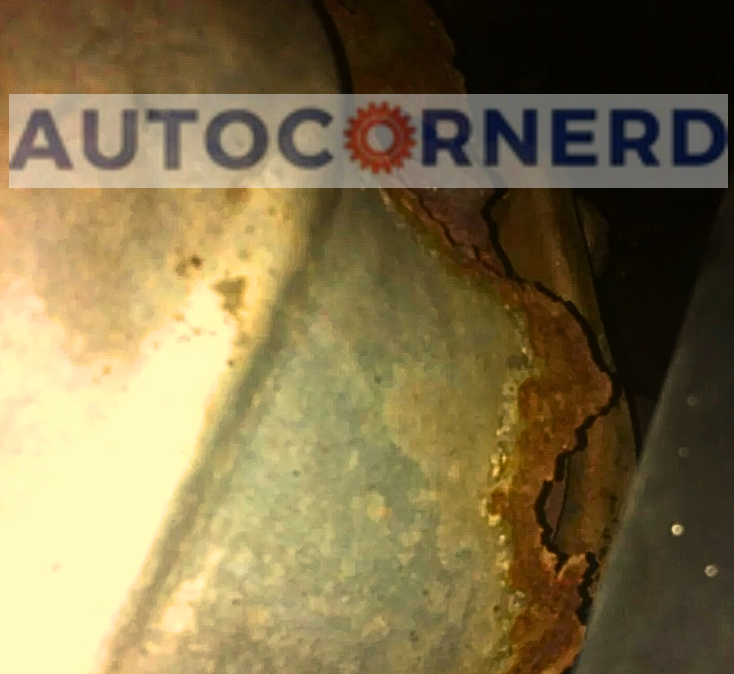
A damaged heat shield around the exhaust pipe or catalytic converter is one of the most common causes of rattling noise from the engine at idle.
Heat shield rattle is a common problem in many cars today. It is caused by a damaged or loose heat shield and is a nuisance, especially at idle.
When the car is idling in drive and you hear a rattling sound, the engine strains against its mounts, which puts the exhaust pipe in a slightly different position than when you’re idling in neutral. As a result, a gap is created between the heat shield and the pipe which causes a rattling sound.
You can also read my guide on causes of Car vibrating in drive but not in neutral.
The heat shield is typically bolted or riveted to the exhaust system and is designed to absorb and dissipate heat away from the engine and its components.
In some cars like Acura, you will also find a heat shield around the intermediate drive shaft to reduce the heat transfer from the exhaust to the drive shaft.
How do they become bad?
Over time, the spot welds and rivets holding heat shields in place can come loose. Rust and corrosion make the problem worse. When a shield gets damaged or loose, it can start rattling around at idle.
How to spot?
To find a rattling shield, first put on some thick gloves to protect your hands from the hot engine. Leather welding gloves work well.
Start the engine and let it warm up for a few minutes. Watch the heat shields closely to see if anything moves around.
Once you see a potential source, use a stick or screwdriver to gently push on the shields. Apply pressure slowly and evenly. This confirms whether that heat shield causes the noise. If pushing on it stops the rattle, you’ve found the culprit.
How To Fix Heat Shield Rattle?
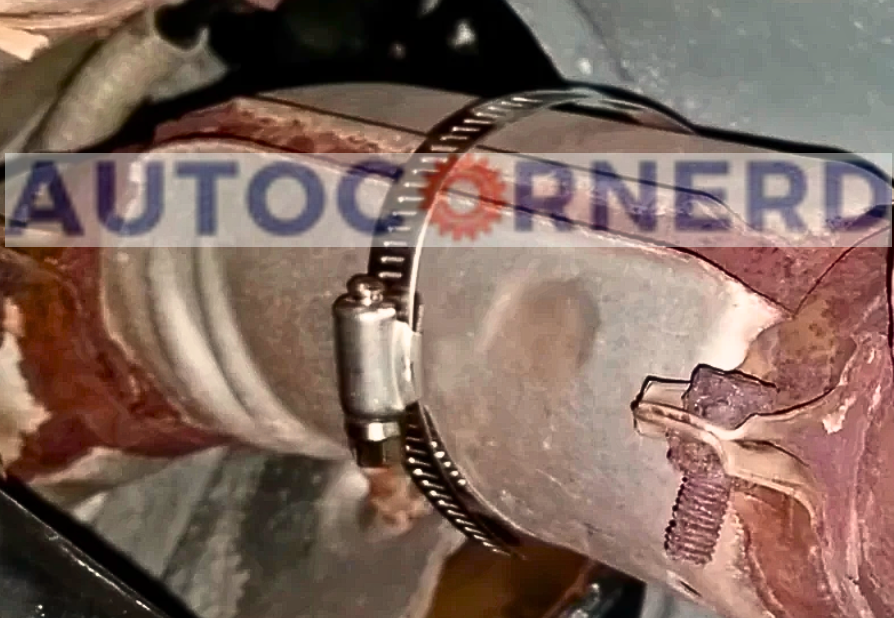
You can use a hose clamp to fix the heat shield rattle in the car. You can also try tightening the screws and bolts of the heat shield to fix the rattle.
One person faced the car rattling issue due to a loose heat shield. He simply fixed it with a worm clamp as you can see in the picture below:
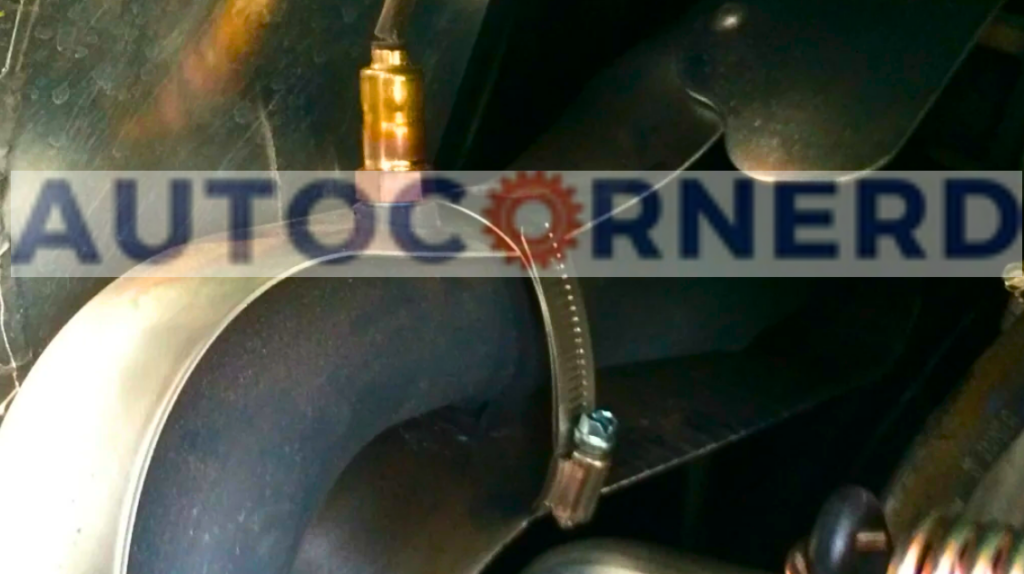
2. Pre-ignition, Spark Plug Knock or Detonation
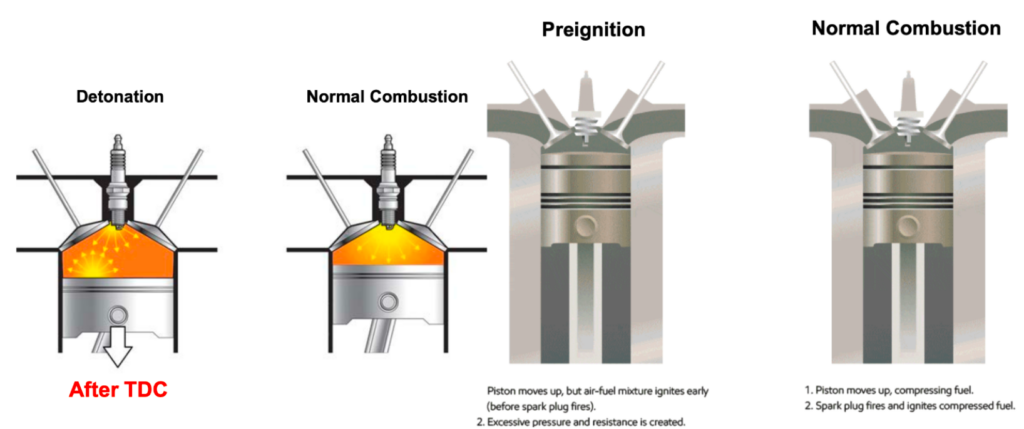
Your car may shake or you may hear a knocking or rattling noise from your car’s engine sometimes. This is called “engine knock” or “detonation.” It happens when the air and fuel mixture ignites too early with a loud bang.
Engine knock occurs because the air and fuel get so hot and compressed that they explode before the spark plug fires. The sudden increase in pressure makes a knocking or pinging sound, most noticeable at idle. This can affect how your engine runs.
There’s a small difference between detonation and pre-ignition. With pre-ignition, the spark plug starts the combustion before it should, also causing a loud knock.
Detonation is when extra fuel explodes after normal combustion, during the compression stroke. Both pre-ignition and detonation mean the air-fuel mixture is igniting too early, creating noise and pressure problems.
How To Spot Detonation In Engine?
There are a few common causes of spark detonation, including:
- Bad Gas: Low quality or low octane gas can detonate too easily from the heat and pressure inside an engine. Time for better fuel.
- Dirty Air Filter: When the air filter gets clogged up, too much gas gets mixed in with the air. That extra fuel can ignite too soon.
- Old Spark Plugs: Worn out spark plugs might misfire or spark too early, igniting the fuel mix at the wrong moment.
- Incorrect Spark Plug Gap: An improper gap between the electrodes on a spark plug can also make it fire too early.
- Engine Gunk: Carbon deposits inside the engine from bad fuel injectors or bad fuel pressure regulators can heat up and ignite fuel where they shouldn’t.
- Bad Timing: If engine sensors are off, the spark might happen too soon instead of at just the right moment.
- Overheating Issues: An overheating engine at idle can lead to early detonation too. Check that coolant, radiator fan and water pump.
If detonation is the cause of car rattle when stationary, you can use an OBD2 scan tool to find trouble codes stored in the engine’s memory that are causing detonation.
3. Low Oil Pressure At Idle
The annoying rattle or shaking at idle is often caused by low oil pressure. What happens is the oil pressure drops too low while the engine idles. This allows more friction between moving parts that should be slippery smooth. Friction causes vibration, and vibration makes rattling sounds.
There are a few common causes:
- The oil pump is worn out and not pushing enough oil.
- The oil filter is clogged so oil cannot flow well.
- There simply is not enough oil in the system.
That rattling noise means there is damage happening inside your engine. Parts that rely on oil to slide without friction are grinding instead.
You can check my guide on low oil pressure at idle to learn about its causes in detail.
4. Faulty tensioner Or Idler Pulley Of Serpentine Belt
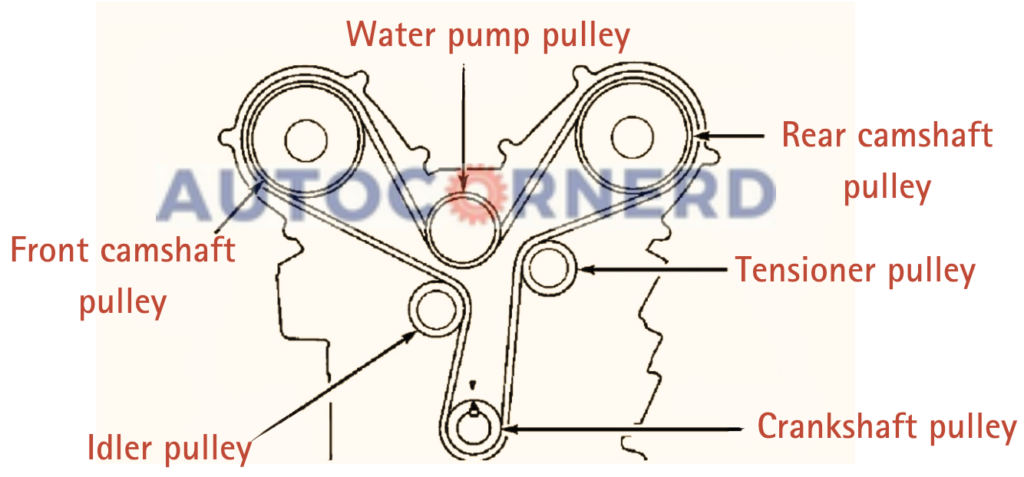
A serpentine belt is a single, continuous belt that travels around several pulleys on your engine. This important belt powers key parts like the alternator, water pump, power steering pump and AC compressor.
You’ll notice the serpentine belt on the front of the engine near the radiator fan, water pump, alternator and other components.
The belt system relies on a tensioner pulley and an idler pulley. The spring-loaded tensioner pulley keeps the belt tight and aligned correctly. The idler pulley lessens friction on the belt and assists with consistent tension. When new, the idler pulley should be fully tight and not spin freely.
Note: If your engine has a timing belt rather than a timing chain, it will also have a tensioner and idler pulley. You’ll spot these on the back of the engine.
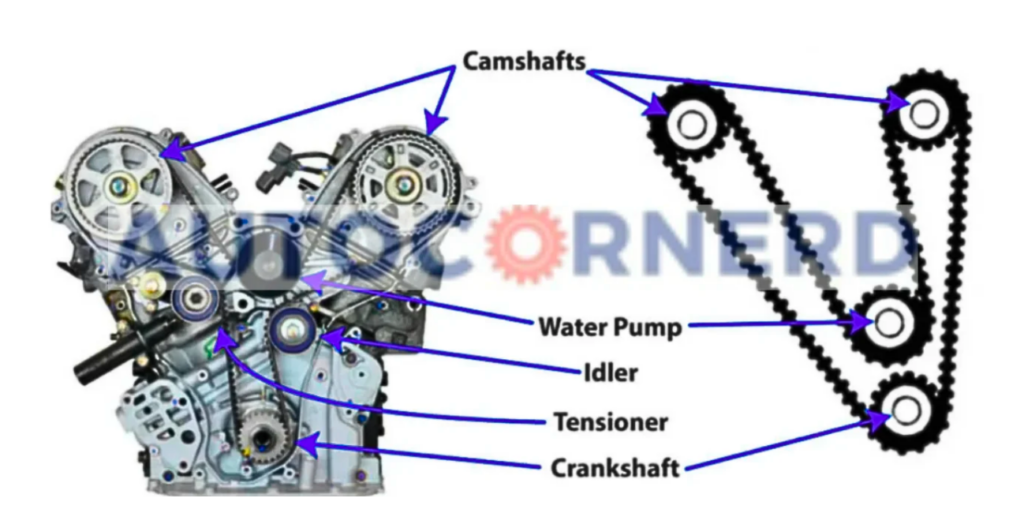
Over time, wear and failure of the tensioner or idler pulley can make the serpentine belt loose. If loose enough, the belt may start to slip. This causes a rattling sound from the engine.
How To Diagnose?
The rattle in your car could be from the idler or tensioner pulley. Let’s check a few things to find the cause.
Make sure the serpentine belt is tight. If it’s loose and jumping around, it can rub on parts in the engine and cause noise.
Also check that the pulley bearings aren’t worn out. Spin the pulleys by hand. If they feel gritty or rough, the bearings are probably bad.
Another clue is side-to-side play in the pulleys. Gently wiggle them back and forth. There shouldn’t be any looseness. If you notice the pulleys moving too much, the bearings could be going bad.
5. Bad Cam phaser and VCT Solenoid
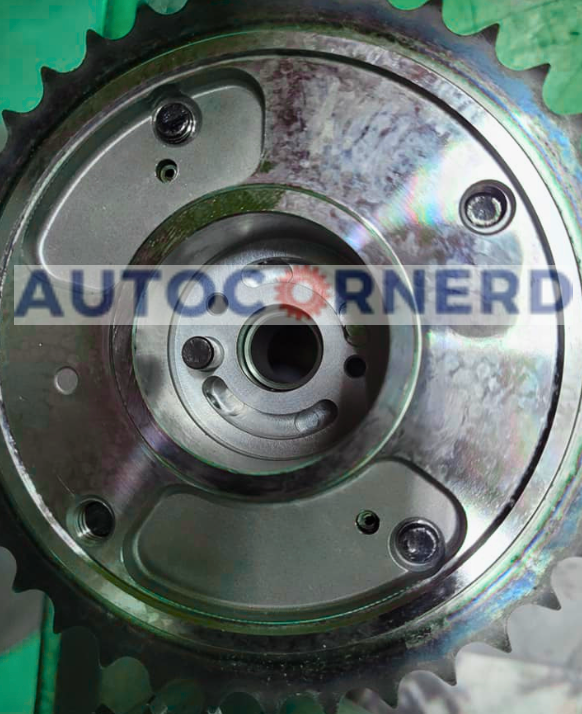
The cam phaser is part of the variable valve timing (VVT) system in your car. It helps change the timing of the intake and exhaust valves as the engine runs. This improves engine performance and efficiency. It also reduces emissions.
The cam phaser looks like a wheel. It connects to the camshafts. The engine’s crankshaft drives it. It is what actually changes the camshaft timing. This opens and closes the inlet and exhaust valves.
When the cam phaser spins, it moves the camshaft timing forward or backward by an angle. This changes when the intake and exhaust valves open and close.
The VCT solenoid is also part of the VVT system. It controls oil flow to the cam phaser. When activated, it lets oil flow to the cam phaser. This closes passages in the cam phaser. It changes valve timing.
If the VCT solenoid fails to send oil to the cam phaser, it will rattle back and forth. This makes your car rattle.
Why do they fail?
A cam phaser and VCT solenoid can fail for a number of reasons. The most common cause of failure is oil contamination. When oil becomes contaminated with dirt or other debris, it can cause the solenoid to become clogged and fail.
Learn more in my guide on consequences of changing oil after 2 years.
How to Fix?
You need to first inspect the VCT solenoid. If it is stuck, it needs to be replaced. A healthy VCT solenoid has a clicking sound when you apply electric current to it.
You should also inspect crankshaft sensor and camshaft sensor as they both send signals to the PCM to control the VCT solenoid.
Next, you should check if there is any debris inside the cam phaser. The Cam phaser has a locking pin that allows oil to enter the chamber of the cam phaser. If the locking pin of the cam phaser is damaged, you have to replace the cam phaser which would cost more than $1000.
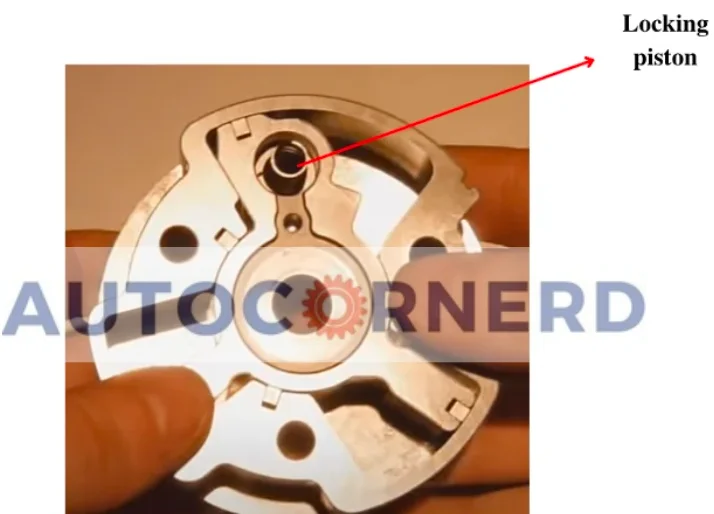
Alternatively, you could use cam phaser lock-out kit if you’re low on budget.
6. Bad Timing Chain
A car’s timing chain has an important job. It makes sure the opening and closing of the intake and exhaust valves happens at the right time with the crankshaft’s rotation.
When a timing chain is worn out or loose, the camshaft and crankshaft can get out of sync. This can make the engine misfire. The misfiring creates a rattling sound. The rattling during misfire happens because the valves open and close at the wrong times.
Why does it happen?
A bad timing chain can be caused by a variety of factors. The most common cause is age. As timing chains age, they become loose and can cause misfiring.
When time chains become slack or are worn:
- The valves can hit the pistons at certain speeds due to disturbance in their timing.
- The timing chains whip back and forth against the guides and timing cover, causing rattling sound.
How to spot the noise?
A mechanic’s stethoscope is an easy way to find the rattling sound from a bad timing chain. Place the stethoscope on the timing cover. Have someone rev up the engine. Listen carefully. If the rattling gets louder on the timing cover, the timing chain likely has an issue.
The timing chain sits inside the timing cover. It needs to run smoothly to work right. If the stethoscope picks up loud rattling on the cover, the chain inside has problems.
7. Bad Catalytic Converter
A bad catalytic converter can also make a car rattle when stationary. The exhaust gases can’t get out when the catalytic converter gets clogged. So the engine has to work harder to push the gases out.
This makes the exhaust gases come out unevenly. This makes the engine shake and rattle when idling.
Another common reason for a car to shake when not moving is a damaged honeycomb inside the catalytic converter.
The honeycomb in the catalytic converter is made of ceramic. It can crack or break over time. This makes pieces break off into the exhaust system. This can make the car rattle when you stop.
How to spot the issue?
To determine whether a rattling noise is caused by a catalytic converter, you can bang the hammer or mallet a couple of times.
If you hear the rattle then the problem is solved. You can also remove the catalytic converter and see if any ceramic falls out.
If a catalytic converter goes bad, it can also throw the P0420 code. You can check it with the OBD2 reader.
8. Loose O2 Sensor
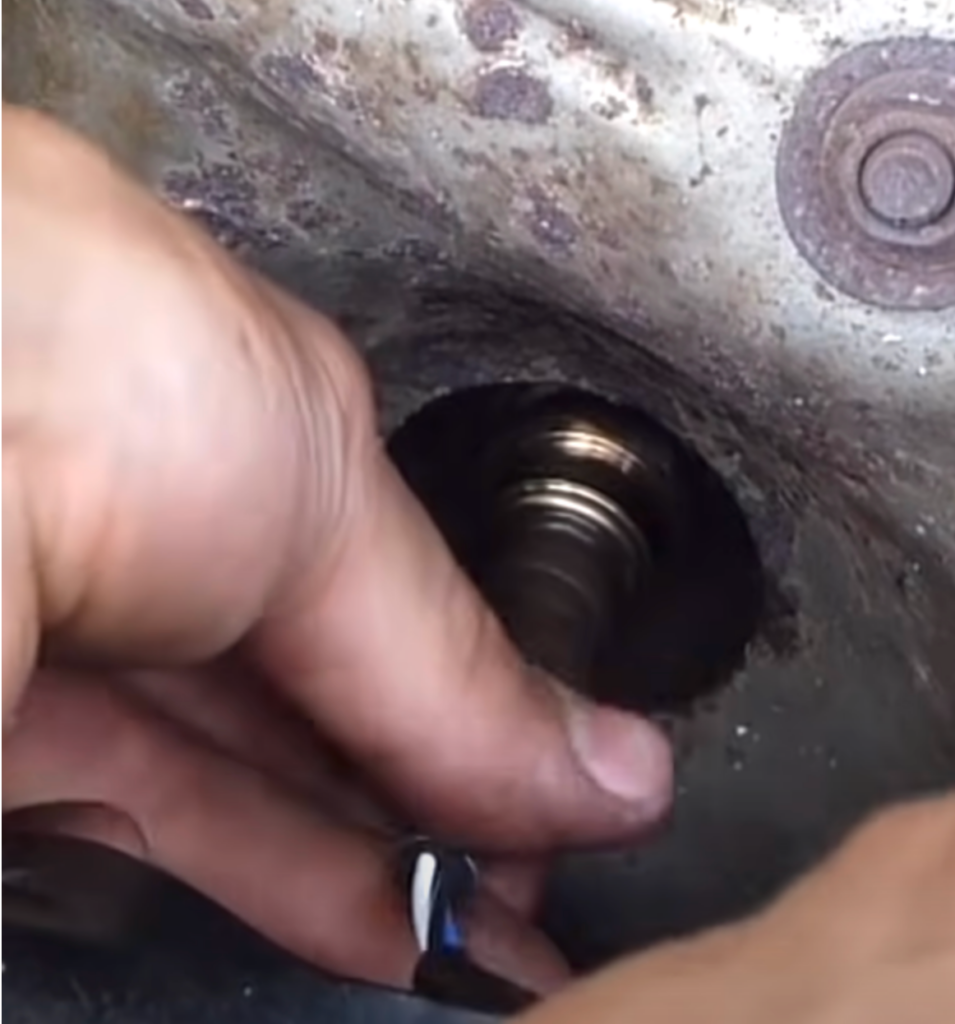
If you’ve noticed a wild rattling noise from your car when you stop, the oxygen (O2) sensor may have come loose.
All cars have an O2 sensor fitted to the exhaust pipe as it exits the engine. This sensor monitors the oxygen in the exhaust fumes from the engine. You’ll hear this rattle most when your car is idling since the engine runs at low ROM. That makes the noise more obvious.
First, know the O2 sensor sits near the exhaust manifold. This part funnels exhaust from the engine cylinders into one pipe.
The O2 sensor has to be close to monitor oxygen levels. But the location means lots of engine vibration. Over time, that can loosen the sensor.
How to diagnose?
If you feel a lot of vibration coming from the exhaust pipe, chances are high that the O2 sensor is loose or damaged.
You can check the oxygen sensor yourself to confirm. Just remove it and look for any signs of wear and tear. These sensors screw into the exhaust pipe using threads. Over time, engine vibrations can wear down the threads, causing the sensor to become loose. A loose oxygen sensor will rattle around at idle speed.
When installing a new O2 sensor, be sure to tighten it to the manufacturer’s recommended torque specification. This will prevent it from loosening over time. Damaged sensors or loose fittings are the usual causes of oxygen sensor rattling.
9. Shaking Of Engine Air Filter Box
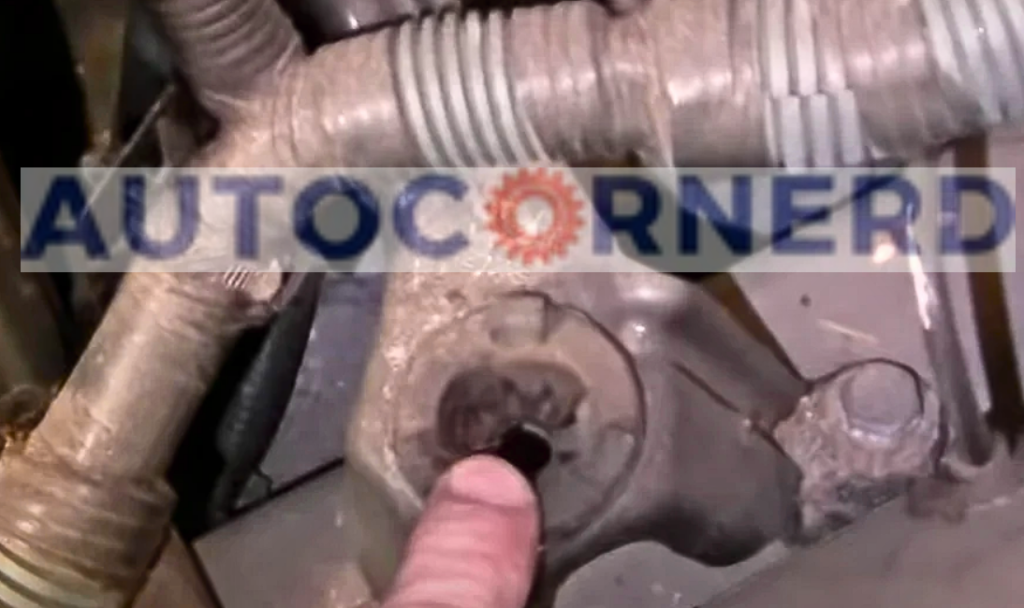
The engine air filter box rests on a rubber grommet. If this rubber grommet goes bad, the airbox will start vibrating.
When the airbox vibrates, the noise travels through the engine body. So your car starts rattling at idle speed.
The retaining clip around the air intake boot can also come loose. If this clip becomes loose, it will cause rattling sound in your car. So check this clip too.
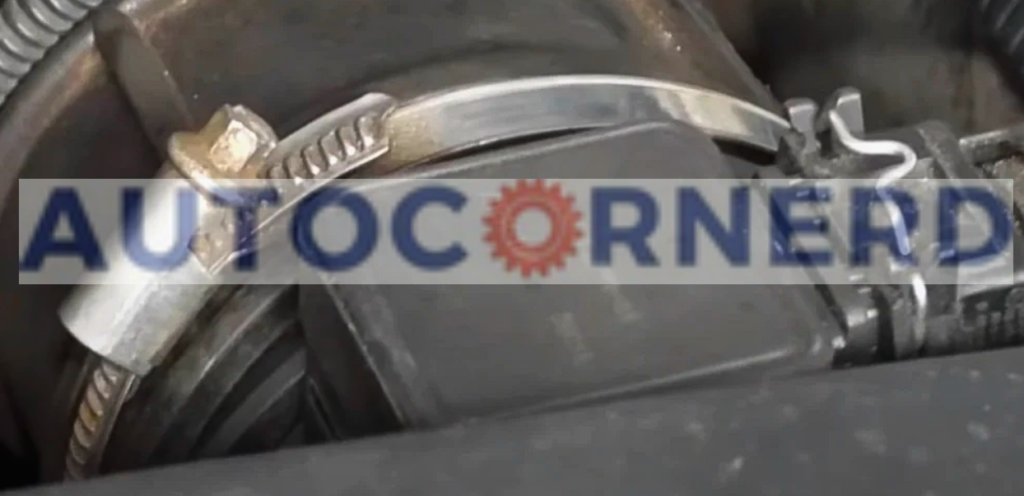
10. Worn Buffer In Battery Tray
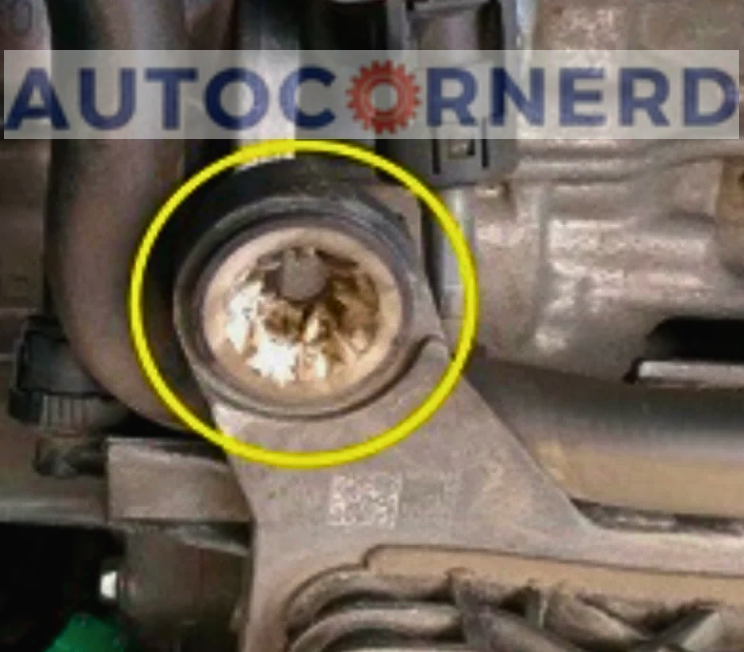
A battery tray can also have a buffer on which the tray rests to dampen the vibrations. If the buffer has worn out, the battery tray will vibrate and cause your car to rattle when stationary. You should also check the car battery hold down. If it is not properly tightened, it can cause your battery to vibrate.
11. Exhaust Leaks
The exhaust pipes let the exhaust gas from the engine go to the back of the car. The pipes are joined together with welding.
A leak happens when there is a hole or crack in the exhaust pipes. This lets the gas escape.
Leaks in the exhaust can cause rattling when the vehicle is idle. The gas escapes at very high pressure if the exhaust is not fully sealed.
This makes the pressure uneven in the exhaust pipes. That can make a rattle sound when the car is idle.
How to spot exhaust leaks?
To detect exhaust leaks, take a shop vac and plug its end that blows air into the tail pipe. Make sure the engine is off. During this process, use a soapy water bottle to check for bubbles at the loose connections of the exhaust system.
You should also check the leakage from the doughnut gasket that prevents exhaust leaks between the cast-iron exhaust manifold and the exhaust pipe. That gasket is a narrow, thin, flat doughnut with a metal ring around the inside and outside.
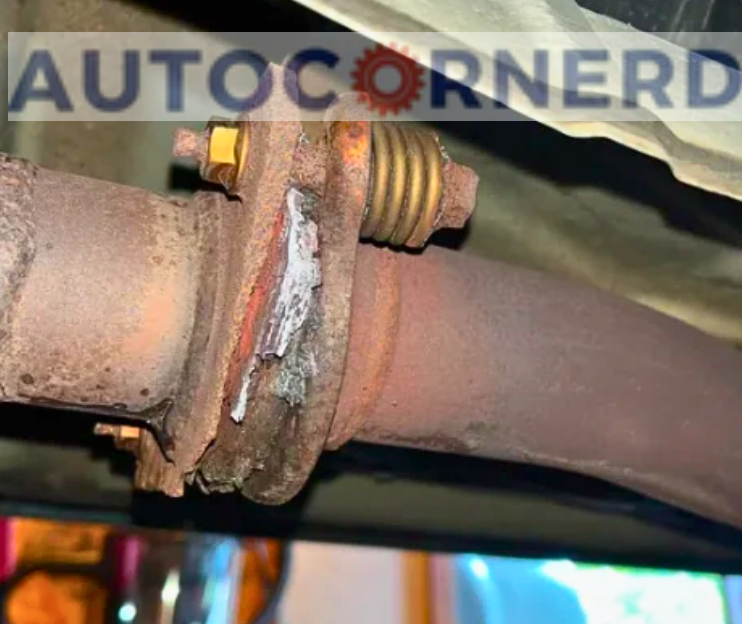
Final Thoughts About Car Rattling When Not in Motion
Ratting in the vehicle at idle can also worry you. We talked about how there are many possible causes. These include loose heat shields or worn engine mounts. Faulty pulleys or bad catalytic converters could also cause it.
The good news is you can likely find the problem if you do some investigating. First look under the hood for any loose parts that are obvious.
Then use a mechanic’s stethoscope to find exactly where the rattle is coming from. After that, go through possible culprits in order. Rev the engine. Tap on parts with a rubber mallet. Use soapy water to check for exhaust leaks.
With time and patience, you’ll find the source of the noise. Fixing it quickly will save you money later. It will also get your car back to running smooth when idling again.
Some First Hand Experiences Shared By Users In Different Communities
Our team conducted research across various online communities, forums, and subreddits to gather user comments and opinions on “car rattling when not in motion”.
User 1 says:
I drive a 2001 Mazda Miata. Noticed a soft rattle at idle, especially at stop lights. At first, I thought it was just age showing, but it turned out to be a loose heat shield around the exhaust. A couple of hose clamps from the hardware store and it was good as new.
User 2 says:
My experience was with a 1999 Toyota Corolla. A persistent rattle at idle led me to investigate the exhaust system. Found out the muffler was rusted through and hanging loose. A new muffler solved the issue.
User 3 says:
My 2005 Ford Mustang had this issue. The rattle was coming from the dashboard area. Turned out to be some loose wiring and a couple of ill-fitted panels. A weekend fix with some basic tools and it was all sorted.
User 4 says:
I have a 2020 Audi Q5 and noticed a rattling sound at idle. After doing some research, I found out it was due to a loose front grille. Secured it properly, and the rattle disappeared. It was an easy fix.
User 5 says:
I own a 2012 BMW 328i, and it started rattling when idling a few months ago. Initially, I ignored it, but it got worse. Turned out to be the timing chain guide. It was a bit pricey to fix, but no more rattle!
